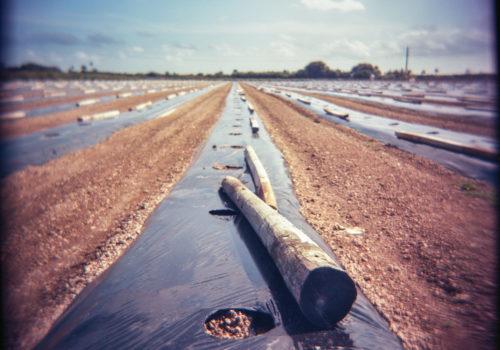RemiJin Camping
Née à Valenzuela, Philippines. She lives in Pembroke Pines, FL.
Farmlands have always had a special place for me. I come from farmers on both sides of my family, rice farmers on my mother’s side, and dairy farmers on my father’s side. I wasn’t raised on a farm myself, but while growing up in the Philippines I lived surrounded by rice, sugarcane, mangoes, coffee, and pineapple farms. I found them mesmerizing, how vast the areas were with uniform patterns created by hand to grow food. Now living here in South Florida, I am near enough to farms where I can go for a drive whenever I feel a need to escape the day-to-day chaos and get myself recentered. The repetition of the rows, the expanse of the sky, and the wide-open space brings me back to a place of happiness and joy, reconnected with my roots and my memories of living in the Philippines.
The origin of photographing Farmland stemmed from a conversation about where our food comes from and what do the plants they grow on look like, specifically the pineapple prior to it being peeled. It was a surprising revelation that so many people are only aware of what the final fruit or vegetable looks like, but not how it looks like when it is in the field growing as a bush, tree, or vine. Curiosity and documentation grew from this humble start to see how plants grow. During the course of a few years while making this series, there was a shift in the reasoning for making this work; it has now morphed into a need to document the farmlands in South Florida due to their shrinking areas from urban expansion. Until recently, I could drive to the Redlands or Homestead and get lost for hours in the farms, happy to find a way to reconnect with my familial roots and memories of my youth. Now, as I drive through the farm areas, there are fewer and fewer to be seen. Urban development has now expanded so much that what was once large fields filled with rows of plants for food has now become rows of townhomes tightly packed together, a memory of what was once there.
These images are made with a medium format Holga camera, a simplistic camera with a plastic lens, using Kodak Ektar color film. It is often referred to as a toy camera as it makes imperfect images, rife with light leaks, blurring, and vignetting. I found this camera to be ideal for this series as the toy camera referred back to my childhood wandering the fields with a point and shoot camera. Visually, the imperfect images reference my memories of that time, memories that I still have but are not the most clear as I get older; as well as the memory of the land in the photos shifting and changing from farms to homes and stores.
RemiJin Camping
https://www.remijin.com/
WOPHA Congress
from October 23 to 26, 2024
www.wophacongress.org
www.wopha.org
















